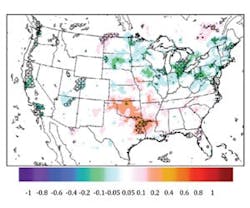Efficacy of Cool Roofs Varies by City
Cool roofs and pavements have been found to cool the planet by preventing energy from radiating back into the atmosphere. But a recent study found that atmospheric feedback – like changes in cloud cover and precipitation – has an important effect that results in different amounts of cooling in different cities.
“Our modeling indicated cool roofs are not necessarily as effective in a city like Dallas as in a city like Los Angeles,” says Dev Millstein, Berkeley lab researcher and postdoctoral fellow in the Atmospheric Sciences Department. “In places near Dallas and parts of the southeast, the absence of summer cooling is associated with less rainfall and more sun reaching the surface.”
The researchers found significant and consistent feedback effects to the solar arrays, including changes in wind patterns several hundred kilometers away. However, any changes to climate at the continental scale were obscured by year-to-year variability.
“Some years it decreased the amount of radiation reflected back to space and some years it increased,” he says. “Without the feedback, you’d always see a penalty, or heating.”
Cool roofs and pavements reflect radiation back into the atmosphere and into space, helping to cool the planet in two ways. At the scale of individual cities, they can combat the urban heat island effect, and at a continental scale, they can combat global warming.
On the local scale, this study validated previous studies finding California and the greater northeast of the U.S. as good candidates for cool roofs. Cities such as Los Angeles, Detroit, and New York saw summer temperatures drop by 0.30-0.53 degrees C. “Half a degree Celsius makes a big difference in terms of air quality,” Millstein says.
But the southeast, some rural areas in Oklahoma, northern Texas, and parts of Louisiana and Florida saw increases in temperature, whereas cities either stayed the same or cooled slightly. But because temperature affects the chemistry of the atmosphere, causing higher ozone levels and more smog, cool roofs can still play an important role in improving air quality.
“Even when you take feedback into account, cool roofs are still beneficial for most places,” says Millstein. “With the exceptions, there may be more study needed. The southeast is certainly not ruled out as a candidate for cool roofs.”
On the global scale, the findings also confirmed the benefit of brightening roofs and pavements. “Even with the feedbacks from decreasing clouds in certain locations, we still had more reflection overall,” he says.
For each square meter of cool roof surface deployed, the increased reflectivity is equivalent to offsetting 175 kilograms of carbon dioxide. For the continental U.S., it would achieve a one-time offset of 3.3 gigatons of CO2, or about half of total U.S. emissions in 2009.
